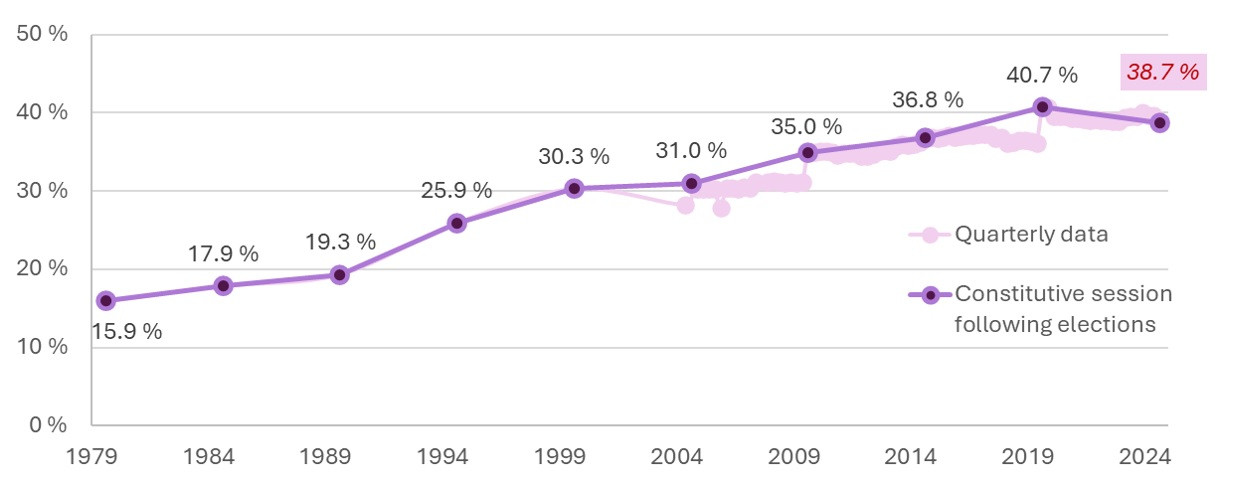First European elections to result in a decrease in women Members of the European Parliament
Following the June 2024 elections, a total of 278 women (38.7 %) and 441 men (61.3 %) took their seats at the constitutive session of the new European Parliament in July ([1]). For the first time in its history, the share of women Members of the European Parliament (MEPs) fell compared with the previous election (June 2019) (Figure 1). The new MEPs did, however, re-elect Ms Roberta Metsola to continue as their president.
Until June 2024, the level of women’s representation in the European Parliament had increased at every election since the first direct elections in 1979 and finally breached the 40 % barrier in 2019 (40.7 %, Figure 1). The quarterly monitoring data collected by the EIGE shows that the level of representation dropped slightly following the departure of the United Kingdom from the European Union in 2020 (39.5 % in March 2020) and remained around this level right up to the 2024 elections (39.7 % in April 2024). The June elections thus represented a key opportunity to push further towards gender parity (i.e. 50 % women, 50 % men) ([2]), but the results instead highlight the need for continued efforts.

Figure 1 – Share of women MEPs, quarterly and representation following constitutive session, 1979–2024
Sources: Data for 1979–1999 are from the European Parliament. Quarterly and constitutive session (corresponding to the third quarter in all election years) data for between 2004 and 2024 are from EIGE’s Gender Statistics Database.
Only five Member States came close to achieving gender parity among their Members of the European Parliament
After the 2019 European Parliament elections, nearly half (13) of the EU Member States (total of 28 at the time, including the United Kingdom) were close to gender parity (i.e. had between 45 % and 55 % of each gender) ([3]) among MEPs ([4]). The 2024 elections saw this number fall to five (see Figure 2). Only three Member States have maintained gender balance since 2019 (Spain, France and the Netherlands). Hungary and Slovakia have shown the largest improvements in their MEP gender balance. This improvement is most notable for Slovakia, where 7 of the 15 MEPs are now women compared with 2 of 13 previously ([5]).
The share of women elected as MEPs in 2024 fell in half of the Member States (15) ([6]), and increased in only 11 ([7]) (Figure 2). Women now account for less than one in five MEPs (< 20 %) in Lithuania (18.2 %), Romania (18.2 %) and, most notably, Malta (16.7 %), where there was previously parity (three of each gender). For the second election in a row, Cyprus did not elect any women to the European Parliament.
Election results beat or matched quota targets in only three cases
Although there have been discussions about the possibility of introducing overarching legislation for elections to the European Parliament, which could open a path for the application of a gender quota for candidates as a means to accelerate progress ([8]), the 2024 elections were still organised independently in each Member State and subject to national legislation. To date, 10 countries have legislated gender quotas applicable to elections to the European Parliament (Figure 2).
While such quotas ensure a minimum share of candidates standing for election, this does not necessarily translate into equivalent election results. Indeed, only three Member States (Spain, France and Croatia) saw the proportion of women MEPs elected in 2024 equal or surpass their respective quota threshold, compared with six Member States in the previous elections ([9]). In both Italy and Greece, the proportion of women MEPs elected is still more than 10 percentage points below the level of the candidate quota (32.9 % v 50 % and 28.6 % v 40 %, respectively).

Figure 2 – Representation and changes (in percentage points) in the share of women MEPs, 2019 v 2024 elections, EU-27
NB:Candidate quotas: 35 % in Poland, 40 % in Greece, Spain, Croatia, Luxembourg, Portugal and Slovenia, and 50 % in Belgium, France and Italy; pp, percentage points.
Source: EIGE’s Gender Statistics Database.
In short, the 2024 elections resulted in a decrease in the share of women MEPs, highlighting the need to intensify efforts and strive for greater progress in achieving gender balance in the European Parliament. The legislative and policy decisions affecting all citizens of the EU thus continue to be taken by a male majority. This outcome should be used as a stimulus to ignite the debate about the possibility of introducing common electoral rules and mechanisms to ensure that women are better represented in the future. The next elections are 5 years away, but action is needed now to ensure that the opportunity for change is successfully seized.
Footnotes
([1]) These women and men represent 719 of the 720 MEPs anticipated by EU legislation. One seat for Spain has not yet been filled. Data published by the European Parliamentary Research Service shows that 38.5 % of MEPs are women because it counted 277 women and recorded one MEP with gender ‘other’.
([2]) See EIGE’s report Gender equality in the European Parliament and in national parliaments in the European Union: 2023 state of play.
([3]) ‘Gender parity’ implies equal numbers of women and men, but the odd number of MEPs in some countries means that this is not possible in all cases. Therefore, this note considers representation between 45 % and 55 % of each sex as being ‘close to’ gender parity.
([4]) Denmark, Ireland, Spain, France, Latvia, Luxembourg, Malta, the Netherlands, Austria, Portugal, Slovenia, Finland and Sweden.
([5]) The number of MEPs per Member State was adjusted following Brexit.
([6]) Bulgaria, Denmark, Estonia, Ireland, Italy, Latvia, Lithuania, Luxembourg, Malta, the Netherlands, Austria, Poland, Portugal, Romania and Slovenia.
([7]) Belgium, Czechia, Germany, Greece, Spain, France, Croatia, Hungary, Slovakia, Finland and Sweden.
([8]) See briefing paper by the European Parliamentary Research Service.
([9]) Spain, France, Luxembourg, Poland, Portugal and Slovenia.